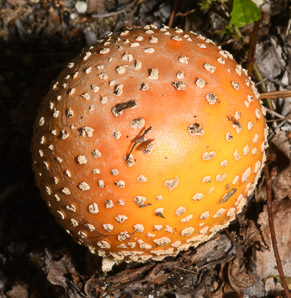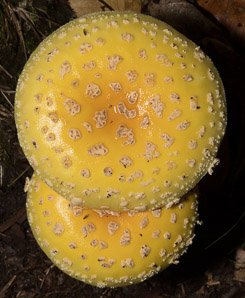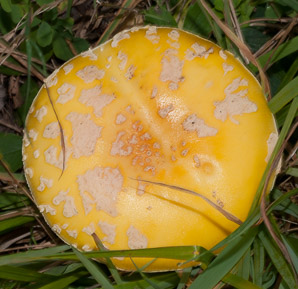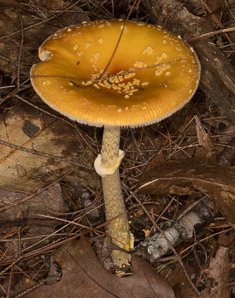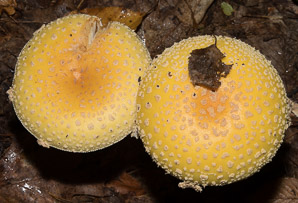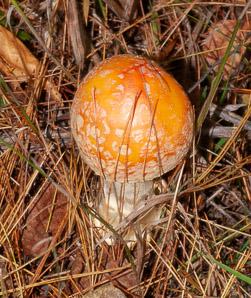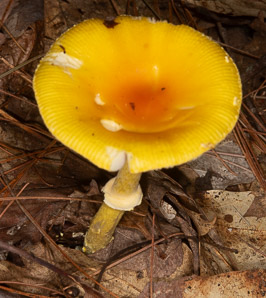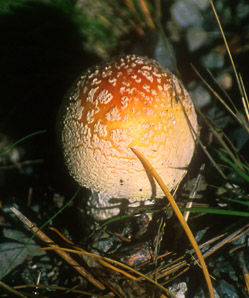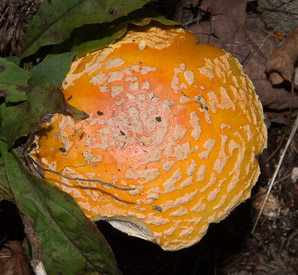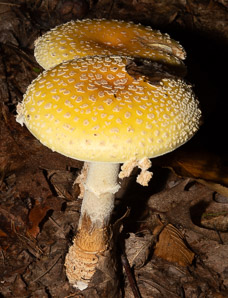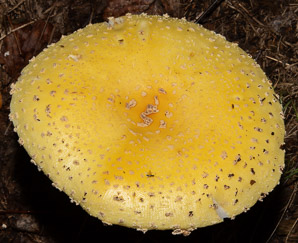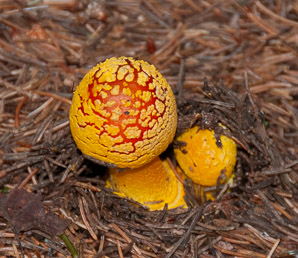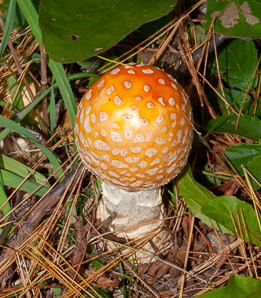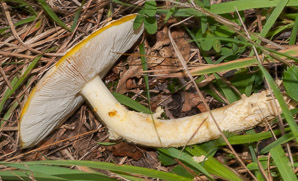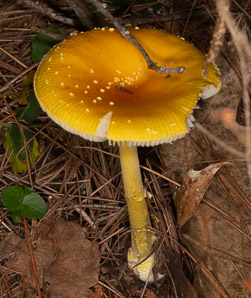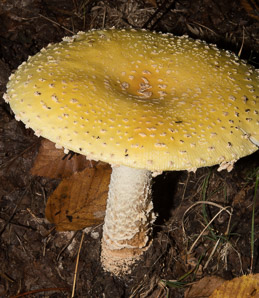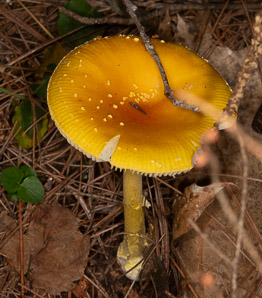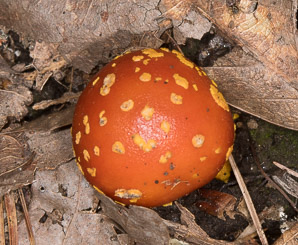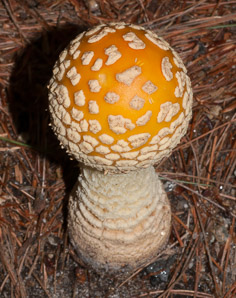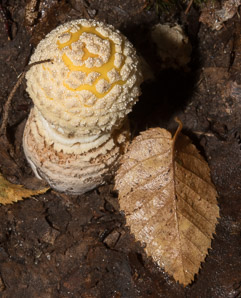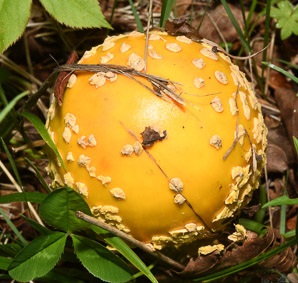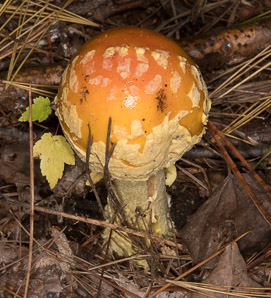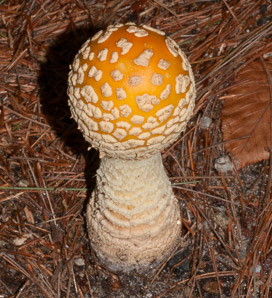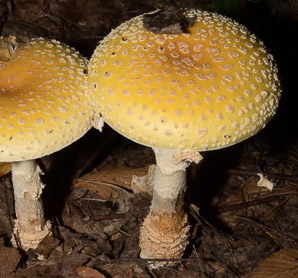
|
Amanita muscaria Fly agaric
Why would a mushroom be named "fly agaric"? I couldn't find a clear answer to this, but "fly" could refer to its historical use as a fly killer, since it contains ibotenic acid. Or it could refer to the delirium it induces if eaten. "Agaric" roughly translates to "mushroom"—it refers to a fungal fruiting body that has a cap that is clearly differentiated from the stalk, with gills on the underside of the cap. In any case, amanitas are attractive, common, and dangerous. Amanitas are the iconic toadstool, or poisonous mushroom. Identification: Caps are bright red in western varieties, orange or yellow in northern and eastern locales; with white, warty spots. They reach 1¾-12″ (5-30 cm) in diameter, and can reach 1′ (30 cm) in height. There are many varieties of amanitas—for a detailed key, see Michael Kuo's at mushroomexpert.com. Edibility: Poisonous ... Depending on habitat and the amount ingested per body weight, effects can range from nausea and twitching to drowsiness, cholinergic crisis-like effects (low blood pressure, sweating and salivation), auditory and visual distortions, mood changes, euphoria, relaxation, ataxia, and loss of equilibrium. That's if the effects are mild. Seizures, coma, and possibly death can occur with stronger doses. The effects of a given dose vary enormously from person to person. There is no antidote. Despite the risks, many earlier peoples have consumed it for its psychoactive effects, a practice that continues to a limited extent even today. Amanita muscaria lacks significant amounts of amatoxins and phallotoxins, which make some of the other amanitas so deadly. But they contain a chemical cocktail I wouldn't mess with:
Online References:
Mykoweb.com: the Fungi of California Tom Volk's Fungi site, at the Department of Biology at the University of Wisconsin Michael Kuo's MushroomExpert.com References:
Unknown Reference! 6/2/2016 · Townsend Wildlife Management Are, Townsend, Massachusetts 9/18/2017 · Purgatory Falls, Mont Vernon, New Hampshire · ≈ 6 × 10″ (16 × 24 cm) 9/25/2011 · Nashua River Rail Trail, Groton Center, Groton, Massachusetts · ≈ 9 × 6″ (23 × 15 cm) 7/23/2021 · Bradbury Mountain State Park, Pownal, Maine · ≈ 7 × 11″ (18 × 28 cm) 9/18/2017 · Purgatory Falls, Mont Vernon, New Hampshire · ≈ 10 × 6″ (24 × 16 cm) 10/16/2011 · Nashua River Rail Trail, Groton Center, Groton, Massachusetts · ≈ 7 × 11″ (18 × 27 cm) 7/28/2017 · Porcupine Trail, Beaver Brook Conservation Area, Hollis, New Hampshire · ≈ 5 × 8″ (13 × 20 cm) 3/4/2001 · Haleakula, Maui, Hawaii 9/29/2013 · North Bubble Hike, Acadia National Park, Bar Harbor, Maine · ≈ 9 × 6″ (23 × 16 cm) 9/18/2017 · Purgatory Falls, Mont Vernon, New Hampshire · ≈ 8 × 12″ (20 × 31 cm)
1From The North American Guide to Common Poisonous Plants and Mushrooms; see reference above
Amanita muscaria description by Thomas H. Kent, last updated 6 May 2023. © FloraFinder.org. All rights reserved. |
9/18/2017 · Purgatory Falls, Mont Vernon, New Hampshire · ≈ 12 × 8″ (31 × 20 cm) 7/19/2009 · Mt. Monadnock, New Hampshire · ≈ 5 × 3½″ (13 × 8.8 cm) 10/16/2011 · Nashua River Rail Trail, Groton Center, Groton, Massachusetts · ≈ 7 × 11″ (18 × 27 cm) 9/25/2011 · Nashua River Rail Trail, Groton Center, Groton, Massachusetts · ≈ 11 × 7″ (27 × 18 cm) 7/28/2017 · Porcupine Trail, Beaver Brook Conservation Area, Hollis, New Hampshire · ≈ 6 × 10″ (16 × 24 cm) 9/18/2017 · Purgatory Falls, Mont Vernon, New Hampshire · ≈ 8 × 12″ (20 × 31 cm) 7/28/2017 · Porcupine Trail, Beaver Brook Conservation Area, Hollis, New Hampshire · ≈ 10 × 6″ (24 × 16 cm) 8/24/2018 · Old Long Loop, Beaver Brook Conservation Area, Hollis, New Hampshire · ≈ 6 × 4″ (16 × 11 cm) 9/26/2011 · Pearl Hill State Park, Townsend, Massachusetts · ≈ 6 × 9″ (15 × 23 cm) 9/18/2017 · Purgatory Falls, Mont Vernon, New Hampshire · ≈ 5 × 8″ (13 × 20 cm) 6/10/2016 · Monhegan Island, Maine 10/10/2016 · Old Meetinghouse Park Trails, Townsend, Massachusetts · ≈ 6 × 10″ (16 × 24 cm) 9/26/2011 · Pearl Hill State Park, Townsend, Massachusetts · ≈ 12 × 8″ (31 × 20 cm) 9/18/2017 · Purgatory Falls, Mont Vernon, New Hampshire · ≈ 8 × 12″ (20 × 31 cm)
|
